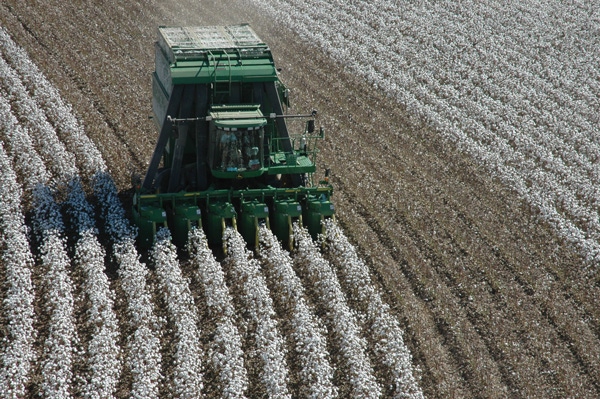
With beneficial rainfall from a tropical storm in early July and timely river irrigations, some yields from the Lower Rio Grande Valley’s 195,000-acre crop have been exceptional.Some our irrigated yields have been really good—over three bales per acre.Yields are averaging 600 to 700 pounds of lint per acre in the Coastal Bend area.
August 17, 2011

As the cotton harvest winds down in South Texas, experts are qualifying their favorable comments with a single word: considering.
“We’ve had a really good cotton year, considering,” said Brad Cowan, a Texas AgriLife Extension Service agent in Hidalgo County. The qualifier, of course, refers to the lingering, record-breaking heat and drought.
“One reason our cotton has done so well is that cotton actually likes hot, dry weather, especially if it can be irrigated or rained upon in a timely fashion,” Cowan said.
With beneficial rainfall from a tropical storm in early July and timely river irrigations, some yields from the Lower Rio Grande Valley’s 195,000-acre crop have been exceptional, he said.
“We’ve got about 20 percent of our crop in Hidalgo County still out in the field, and I suspect we’ll be harvesting right up until the Sept. 1 deadline,” Cowan said. “But some of our irrigated yields have been really good—over three bales per acre. Even some of our dryland growers, not all of them, but some are bragging about their yields too.”
The successful dryland farmers in the Valley were helped by a rain in early May and a moderation of temperatures in June. The later-maturing irrigated crop got a boost from Tropical Storm Don instead of potentially devastating rains that were feared, Cowan said. Normal cotton yields on irrigated fields have averaged two- to two-and-a-half-bales per acre, Cowan said.
“Yields have been going up historically because of better-yielding varieties of cotton that have been introduced to the area,” Cowan said. “But even more significant is the lack of insect damage due to the successful efforts of the boll weevil eradication program.”
Farther north, in the Coastal Bend area, Cowan’s counterpart in Nueces County sums up their harvest in similar words.
“About 98 percent of our cotton has been harvested and yields are fairly respectable, considering what we’ve been through,” said Jeff Stapper, an AgriLife Extension agent near Corpus Christi.
Unlike the Valley, the vast majority of cotton in the Coastal Bend area is grown on dryland fields that depend totally on rainfall.
“Our biggest rain came in mid-May, 1 to 3 inches, and that made our cotton crop because it came just when plants were starting to bloom,” he said. “It was a big help, but then nothing after that. It’s been bone dry.”
Yields are averaging 600 to 700 pounds of lint per acre, Stapper estimates.
“We planted 136,000 acres of cotton in Nueces County, and about 20,000 acres failed,” he said. “It just never came up. But what did survive matured earlier than usual thanks to above-normal heat units in the growing season, so our harvest ended about 20 days earlier than usual.”
Valley cotton gin yards are overflowing with modules, which will take some time to process.
“We don’t have as many gins as we used to,” Cowan said. “And nobody’s sure how long it will take to gin it all, but that’s okay. The weather’s good and cotton stores fairly well once it’s in the gin yard since the tops of the modules are covered with tarps. The sides are open and can get a little wet, but that’s just not an issue.”
Both Cowan and Stapper are now hoping for rain in what’s normally considered the rainy season in South Texas, late August and September.
“Once we get the cotton out of the way, then we’ll be looking for moisture, just like everybody else in agriculture,” Cowan said. “And there’s hope since the weather patterns seem to have changed the past few days.”
Stapper said rainfall is especially critical now.
“We grow some of the state’s best grain sorghum and cotton crops right here in the Coastal Bend area, but now we need some good rains to get us going and help us start preparing for next year,” Stapper said.
With sufficient fall rains, Stapper expects growers will plant a winter crop of 5,000 to 6,000 acres of wheat and a few hundred acres of oilseed crops, including canola, rape and safflower. “Then by the first of February we’ll start planting corn, then grain sorghum and depending on soil temperatures, cotton will start going in the first of March.”
You May Also Like



